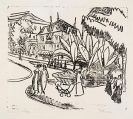
Hendrik Petrus Berlage
Amsterdam
1856 -
Den Haag
1934
Hendrik Petrus Berlage, a Dutch architect and designer, attended the Reichsakademie for Fine Art in Amsterdam with the intention to become a painter. After having spent a year there, Berlage changed his mind and opted to study architecture. In 1875 he enrolled at the architecture school at the Eidgenössische Technische Hochschule in Zurich. There, Hendrik Petrus Berlage studied under Gottfried Semper, whom he greatly admired, until 1878. After finishing his studies, Hendrik Paulus Berlage took the classic 19th-century Grand Tour, traveling extensively in Germany and Italy before returning to the city of his birth. From 1881 Berlage was employed in the studio of the Amsterdam architect Theodor Sanders, whose business partner he was from 1884 to 1889. In 1889 Hendrik Petrus Berlage opened his own architectural practice. In 1896 he won the competition to design the Beurs (Commodity Exchange) in Amsterdam, for which he had submitted a design in 1884. Completed in 1903, the Commodity Exchange was Hendrik Petrus Berlage's first big commission, which immediately earned him renown. At the same time Berlage designed the Diamond Guild Building (1897-1900) in Amsterdam. In 1900 Berlage and J. van den Bosch opened the "'t Binnenhuis" gallery, where they sold the furniture and crafts objects they had designed. That same year Hendrik Petrus Berlage was invited to submit plans for the southern extension of Amsterdam. Berlage's most important urban planning commission kept him busy until 1915. In 1911 he traveled through the US, where he saw buildings by Louis Sullivan and Frank Lloyd Wright. In 1913 he moved to The Hague, where he built a house for himself. Berlage's last important building was the Gemeentemuseum in The Hague (1919-1935), which was not finished until shortly after his death. Hendrik Petrus Berlage was a pioneering modern architect in the Netherlands and the founder of the "Amsterdam School". In his 1905 essay "Gedanken über Stil in der Baukunst" he vehemently derided the historicizing buildings of the 19th century as pompous, praising instead the simplicity and purity of early period styles of architecture. His criticism was that historicizing architecture was more appearance than real art, that too much was imitation, and more iron was used than stone.
Would you like to sell a work by Hendrik Petrus Berlage?
Infos for seller







![Otto Mueller - Zwei Zigeunermädchen im Wohnraum [historischer Titel]](https://www.kettererkunst.de/still/kunst/picm/22/125000258.jpg)




